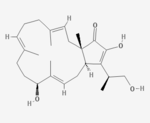Terpestacin
 | |
| Identifiers | |
|---|---|
3D model (JSmol) |
|
| ChemSpider | |
PubChem CID |
|
| |
| |
Except where otherwise noted, data are given for materials in their standard state (at 25 °C [77 °F], 100 kPa). | |
| Infobox references | |
Terpestacin[1] is a fungal metabolite with anticancer activity.
References
- ↑ Chan, Johann; Jamison, Timothy F. (September 2003). "Synthesis of (−)-Terpestacin via Catalytic, Stereoselective Fragment Coupling: Siccanol Is Terpestacin, Not 11- -Terpestacin". Journal of the American Chemical Society. 125 (38): 11514–11515. doi:10.1021/ja0373925. PMID 13129351.
External links
- Grigoriev PA, Schlegel B, Schmidtke M, Gräfe U (September 2002). "Alteration of membrane polarization by (−)-terpestacin, a biologically active fungal metabolite". Die Pharmazie. 57 (9): 653–4. PMID 12369460.
- Jung HJ, Shim JS, Lee J, Song YM, Park KC, Choi SH, Kim ND, Yoon JH, Mungai PT, Schumacker PT, Kwon HJ (April 2010). "Terpestacin inhibits tumor angiogenesis by targeting UQCRB of mitochondrial complex III and suppressing hypoxia-induced reactive oxygen species production and cellular oxygen sensing". J Biol Chem. 285 (15): 11584–95. doi:10.1074/jbc.M109.087809. PMC 2857036. PMID 20145250.
- Park KC, Choi SH (December 2013). "Effects of endostatin and a new drug terpestacin against human neuroblastoma xenograft and cell lines". Pediatric Surgery International. 29 (12): 1327–40. doi:10.1007/s00383-013-3398-1. PMID 24072200.
This article is issued from
Wikipedia.
The text is licensed under Creative Commons - Attribution - Sharealike.
Additional terms may apply for the media files.